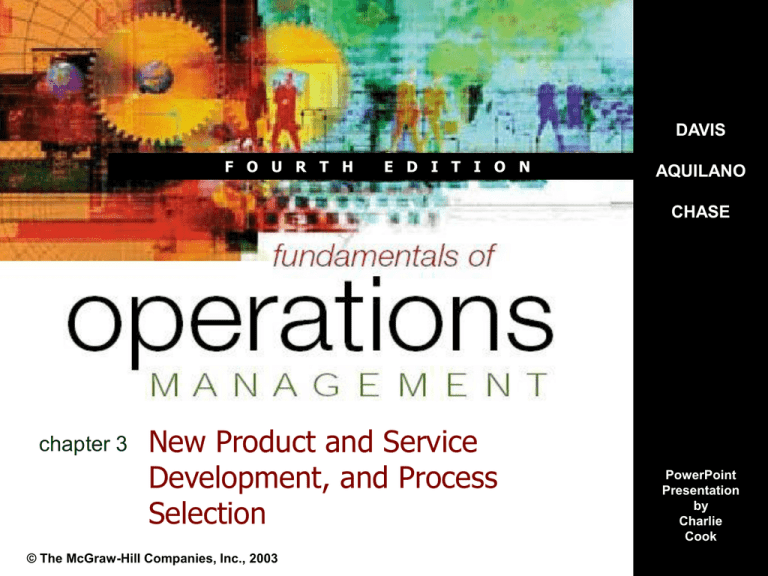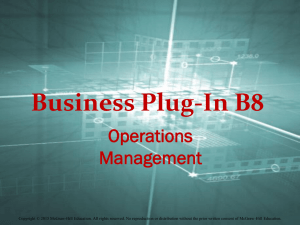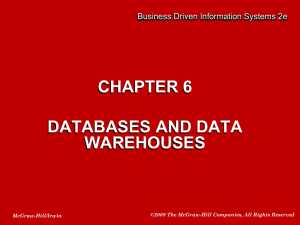
DAVIS
F O U R T H
E D I T I O N
AQUILANO
CHASE
chapter 3
New Product and Service
Development, and Process
Selection
© The McGraw-Hill Companies, Inc., 2003
PowerPoint
Presentation
by
Charlie
Cook
Chapter Objectives
• Illustrate the importance of the development of new
products and services to a firm’s competitiveness.
• Identify the various types of new products that are
developed by companies.
• Introduce the new product design process and the
concept of a product’s life cycle.
• Demonstrate the necessity of concurrent product and
process design as a new product or service is
developed.
• Present a framework for understanding how new
services are developed and introduced into the
marketplace.
Fundamentals of Operations Management 4e
© The McGraw-Hill Companies, Inc., 2003
3–2
Managerial Issues
• Product life cycles becoming shorter.
–The need to bring products to market more
quickly and efficiently.
• Conducting product development on a
continuous basis.
–New products may represent a majority of sales
and profits.
Fundamentals of Operations Management 4e
© The McGraw-Hill Companies, Inc., 2003
3–3
Why the Emphasis on New
Goods and Services
• Increased Competition
–Improved worldwide telecommunications
–Lower trade barriers (import duties and tariffs)
and the creation of trade organizations (NAFTA
and European Union)
–Faster transportation of goods
• Advances in Technology
–Products become obsolete faster.
–Improved manufacturing processes (CAD and
CAM and industrial robots)
Fundamentals of Operations Management 4e
© The McGraw-Hill Companies, Inc., 2003
3–4
The Benefits of Introducing
New Products Faster
• Greater Market Share
–Early entry captures large initial market share.
• Price Premiums
–Ability to initially charge more for new products.
• Quick Reaction to Competition
–Rapid response to competitor’s new products.
• Set Industry Standards
–Initial product sets market/industry standards.
Fundamentals of Operations Management 4e
© The McGraw-Hill Companies, Inc., 2003
3–5
The Impact of Speed to Market on Sales
Exhibit 3.1a
Fundamentals of Operations Management 4e
© The McGraw-Hill Companies, Inc., 2003
3–6
The Impact of Speed to Market on
Profit Margins
Exhibit 3.1b
Fundamentals of Operations Management 4e
© The McGraw-Hill Companies, Inc., 2003
3–7
The Impact of Speed to Market on Profits
Exhibit 3.1c
Fundamentals of Operations Management 4e
© The McGraw-Hill Companies, Inc., 2003
3–8
Categories of New Products
• Incremental or Derivative Products
–Are hybrids or enhancements of existing
products.
–Require minimal changes in design or process,
allowing for quick development.
–Require fewer resources to develop new
features or functions.
–Help ensure near-term cash flows by
maintaining current market share.
Fundamentals of Operations Management 4e
© The McGraw-Hill Companies, Inc., 2003
3–9
Categories of New Products
• Next Generation or Platform Products
–Represent new “system” solutions for
customers.
• Require more resources to develop.
• Are key to continued product revenue growth.
• Breakthrough or Radical Products
–Create new product categories as core
businesses.
–Require substantial design and process change.
–Render existing products obsolete in long-term.
Fundamentals of Operations Management 4e
© The McGraw-Hill Companies, Inc., 2003
3–10
The Trend toward Shorter
Product Development Times
Source: Data: Product Development & Management
Association, Business Week, January 27, 1997, p. 6.
Fundamentals of Operations Management 4e
Exhibit 3.2
© The McGraw-Hill Companies, Inc., 2003
3–11
The New Product
Development (NPD) Process
• New Product Development Process
–The method by which new products evolve from
conceptualization through engineering to
manufacturing and marketing.
• Market Success Depends on NPD
–Continuously generate new product ideas.
–Convert ideas to reliable functional designs.
–Ensure that the designs are readily producible.
–Select the processes most compatible with
customer needs.
Fundamentals of Operations Management 4e
© The McGraw-Hill Companies, Inc., 2003
3–12
Sequential Flow of Activities in
Product Design and Process Selection
Source: Reprinted with the permission of the Free Press, an imprint of Simon &
Schuster from Fast Cycle Times: How to Align Purpose, Strategy, and Structure
for Speed by Christopher Meyer. Copyright © 1993 by Christopher Meyer.
Fundamentals of Operations Management 4e
Exhibit 3.3
© The McGraw-Hill Companies, Inc., 2003
3–13
The New Product
Development (NPD) Process
• Concurrent Engineering
–The simultaneous and coordinated efforts of all
functional areas which accelerates the time to
market for new products.
Fundamentals of Operations Management 4e
© The McGraw-Hill Companies, Inc., 2003
3–14
Concurrent Engineering Approach to NPD
Exhibit 3.4
Fundamentals of Operations Management 4e
© The McGraw-Hill Companies, Inc., 2003
3–15
The New Product Development
(NPD) Process (cont’d)
• Idea Generation
–Market pull: the “voice of the customer” in
providing feedback to determine product
specifications.
–Technology push: a product developed by the
firm’s R&D is “pushed” into the market.
• Concept Development
–Initial product design developed and tested.
–Analysis of the market and customer
requirements.
Fundamentals of Operations Management 4e
© The McGraw-Hill Companies, Inc., 2003
3–16
The New Product Development
(NPD) Process (cont’d)
• Quality Function Deployment (QFD)
–The process for translating customer
requirements into a product’s design.
• Voice of the Customer
–Customer feedback is used in QFD process to
determine product specifications.
–Customer attributes:
• Product needs
• Product preferences
Fundamentals of Operations Management 4e
© The McGraw-Hill Companies, Inc., 2003
3–17
The New Product Development
(NPD) Process (cont’d)
• House of Quality
–The part of the QFD process that uses customer
feedback for product design criteria.
–Use of QFD teams
• Identify important customer attributes.
• Design superior product.
• Shorten product design time.
• Facilitate interfunctional cooperation.
Fundamentals of Operations Management 4e
© The McGraw-Hill Companies, Inc., 2003
3–18
Completed
House of
Quality
Matrix
for a Car
Door
Exhibit 3.5
Fundamentals of Operations Management 4e
© The McGraw-Hill Companies, Inc., 2003
3–19
The New Product Development
(NPD) Process (cont’d)
• New Product Planning
–Build models of new product.
–Test new elements and components.
–Conduct detailed investment and financial
analyses of product’s anticipated life cycle.
Fundamentals of Operations Management 4e
© The McGraw-Hill Companies, Inc., 2003
3–20
The New Product Development
(NPD) Process (cont’d)
• Design for Manufacturability (DFM)
–Choosing manufacturing methods and
materials.
–Minimizing the number of individual parts:
• Reduces assembly time.
• Increases reliability.
– Setting product specifications.
• Output from the design activity that states all
criteria for building a product.
Fundamentals of Operations Management 4e
© The McGraw-Hill Companies, Inc., 2003
3–21
Design Change to Reduce
the Number of Parts in a Bracket
Exhibit 3.6
Fundamentals of Operations Management 4e
© The McGraw-Hill Companies, Inc., 2003
3–22
Process Selection in Manufacturing
• Types of Processes
–Project process
• Process that focuses on making one-of-a-kind
products.
–Intermittent process
• Process that produces products in small lot sizes
(e.g., job and batch operations).
–Line-flow process
• Continuous process that produces high volume,
highly standardized products (e.g., assembly-line
and continuous operations).
Fundamentals of Operations Management 4e
© The McGraw-Hill Companies, Inc., 2003
3–23
Types of Processes
Exhibit 3.7
Fundamentals of Operations Management 4e
© The McGraw-Hill Companies, Inc., 2003
3–24
Process Selection in Manufacturing
• The Product-Process Matrix
–High production volumes and narrow product
lines make specialized equipment and
standardized materials economically feasible.
• Remaining in a process niche after the product
cycle has advanced to its next stage dooms a firm
to market failure.
Fundamentals of Operations Management 4e
© The McGraw-Hill Companies, Inc., 2003
3–25
Matching Major Stages of
Product and Process Life Cycles
Source: Adapted from Robert Hay and Steven Wheelwright, Restoring Competitive Edge:
Competing through Manufacturing (New York: John Wiley & Sons, 1984).
Fundamentals of Operations Management 4e
Exhibit 3.8
© The McGraw-Hill Companies, Inc., 2003
3–26
Product and Process Life Cycles
Exhibit 3.9
Fundamentals of Operations Management 4e
© The McGraw-Hill Companies, Inc., 2003
3–27
Types of Incremental and New Services
Exhibit 3.10
Fundamentals of Operations Management 4e
© The McGraw-Hill Companies, Inc., 2003
3–28
Categories of New Services
• Incremental services
–Service line extensions
• New services that augment current services.
–Service improvements
• New services in which features have changed
relative to existing services.
–Style changes
• Modest forms of new services that change only
the appearance of the service.
Fundamentals of Operations Management 4e
© The McGraw-Hill Companies, Inc., 2003
3–29
Categories of New Services (cont’d)
• Radical
–Major innovations
• New services in markets not fully defined.
–Start-up services
• New services in established markets already
served by existing services.
–New services for current markets
• Added services to current customers.
Fundamentals of Operations Management 4e
© The McGraw-Hill Companies, Inc., 2003
3–30
A Framework for Categorizing New Services
Exhibit 3.11
Fundamentals of Operations Management 4e
© The McGraw-Hill Companies, Inc., 2003
3–31
Categories of New Services
Service Category
Content Change
“Window Dressing”
Not significantly different from other
services
Delivered in similar fashion
Breadth of Offering
Significant design change in content of
service
Delivered in similar fashion
Revolutionary
New in both content and delivery
method
Channel Development
Delivery of same/existing service
through a different/new channel
Fundamentals of Operations Management 4e
© The McGraw-Hill Companies, Inc., 2003
3–32
The New Service Development (NSD) Process
Stage
Activity
Design
Formulating the objectives and strategy of the
new service.
Analysis
Considering the financial implications of the
new service.
Examining supply chain issues for delivery of
service.
Development
Testing the service design, training
personnel, conducting pilot runs.
Full Launch
Releasing the service to the market place.
Fundamentals of Operations Management 4e
© The McGraw-Hill Companies, Inc., 2003
3–33
The Customer Contact Approach to
Designing Service Processes
• Customer Contact
–The presence of the customer in the system.
• Extent of Contact
–The percent of time the customer is involved
relative to the time required to deliver the
service.
• Creation of the Service
–The work process involved in providing the
service.
Fundamentals of Operations Management 4e
© The McGraw-Hill Companies, Inc., 2003
3–34
The Customer Contact Approach to
Designing Service Processes
High Degree
of Customer
Contact
High
Low Degree
of Customer
Contact
Percentage of customer contact
(customer influence on the system)
Difficulty in managing system
Fundamentals of Operations Management 4e
Low
© The McGraw-Hill Companies, Inc., 2003
3–35
Major Differences between High- and LowContact Systems in a Bank
Exhibit 3.12
Fundamentals of Operations Management 4e
© The McGraw-Hill Companies, Inc., 2003
3–36
The Service Process Matrix
Source: Roger W. Schemenner, “How Can Service Businesses Survive and
Prosper?” Sloan Management Review 27, no. 3 (Spring 1986), pp. 21–32,
by permission of publisher. Copyright 1986 by Sloan Management Review
Association, All rights reserved.
Fundamentals of Operations Management 4e
Exhibit 3.13
© The McGraw-Hill Companies, Inc., 2003
3–37
Designing a New Service Organization
• “Service Vision” (Heskett)
–Identification of the target market
• Who is our customer?
–Defining the service concept
• How do we differentiate our service in the market?
–Developing the service strategy
• What is our service package and its operating
focus?
–Creating the service delivery system
• What processes, staff, and facilities are needed?
Fundamentals of Operations Management 4e
© The McGraw-Hill Companies, Inc., 2003
3–38
Designing a New Service Organization
(cont’d)
• Differences in service design and
manufacturing product development:
–Service design and process development are
simultaneous.
–Service operations cannot be copyrighted to
protect them from imitation by competitors.
–The service package is the major output of NSD.
–Prior training strongly influences the service
package.
–Service organizations can change their service
offerings very rapidly.
Fundamentals of Operations Management 4e
© The McGraw-Hill Companies, Inc., 2003
3–39
Service-System Design Matrix
Exhibit 3.14
Fundamentals of Operations Management 4e
© The McGraw-Hill Companies, Inc., 2003
3–40
Strategic Uses of the
Service-System Design Matrix
1. Enabling systematic integration of operations and
marketing strategy.
2. Clarifying exactly which combination of service
delivery the firm is actually providing.
3. Permitting comparison with other firms in the way
specific services are delivered.
4. Indicating evolutionary or life cycle changes that
might be in order as the firm grows.
5. Providing flexibility.
Fundamentals of Operations Management 4e
© The McGraw-Hill Companies, Inc., 2003
3–41
Process Selection in Services
• Types of Service Organizations
–Service businesses
• Facilities-based services that provide assistance
to customers who come to the service facility.
• Field-based services that provide on-site services
to customers.
–Customer support services
• Provide product information and services to
current external customers.
–Internal services
• Provide services for other internal organizational
units.
Fundamentals of Operations Management 4e
© The McGraw-Hill Companies, Inc., 2003
3–42
Process Selection in Services (cont’d)
• The Production Line Approach
–Orientation is toward the efficient production of
results—precisely controlled execution of the
“central function”.
• The Customer Involvement Approach
–Having the customer take a greater participatory
role in the production of the service.
• The Personal Attention Approach
–The central focus is complete customer
attention and satisfaction at all times.
Fundamentals of Operations Management 4e
© The McGraw-Hill Companies, Inc., 2003
3–43
Common Characteristics of
Well-Designed Service Systems
1. Each element of the service system is consistent
with the operating focus of the firm.
2. It is user-friendly—customers can interact easily.
3. It is robust—capable of coping with variations in
demand and resources availability
4. It is structured so that consistent performance by its
people and systems is easily maintained.
5. It provides effective links between the back office
and the front office so that nothing falls between the
cracks.
Fundamentals of Operations Management 4e
© The McGraw-Hill Companies, Inc., 2003
3–44
Common Characteristics of
Well-Designed Service Systems (cont’d)
6. It manages the evidence of service quality in such a
way that customers see the value of the service
provided.
7. It is cost-effective—there is a minimum waste of time
and resources in delivering the service.
Fundamentals of Operations Management 4e
© The McGraw-Hill Companies, Inc., 2003
3–45




